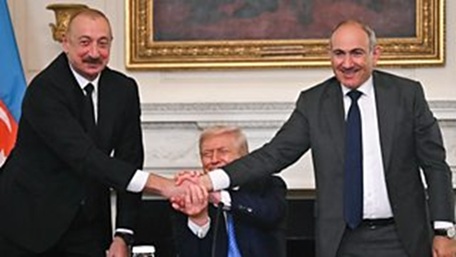| (Prelims: Current Affairs) |
Context
The decades-long Nagorno-Karabakh conflict in the South Caucasus region led to deep mistrust, violence and political instability between Azerbaijan and Armenia. After years of bloody conflict, displacement and failed negotiations, a historic peace agreement was signed in Washington, brokered by US President Donald Trump, which both countries described as the 'beginning of a new era'.

Background of the conflict
- Nagorno-Karabakh, which is internationally part of Azerbaijan, had a majority population of ethnic Armenians.
- The two countries fought a fierce war in the 1980s and 1990s, displacing millions and killing thousands.
- A six-week war broke out in 2020, with Azerbaijan recapturing large parts of the region.
- In recent years, Russia's focus on the Ukraine war and Armenia's tilt towards the West have brought new equations in the peace process.
About the peace deal
- Azerbaijani President Ilham Aliyev and Armenian Prime Minister Nikol Pashinyan signed the deal in the presence of US President Donald Trump at the White House.
- The deal promises to end the war "forever" and restore traffic, trade and diplomatic relations between the two countries.
- The US will build a major transit corridor in the region, named the 'Trump Route for International Peace and Prosperity'.
- The route will connect Azerbaijan to its Nakhchivan exclave, which is separated from Armenian territory.
Key points of the deal
- Permanent ceasefire: Both countries pledged not to take any military action in the future.
- Transport and trade resumed: Road, rail and air routes will be opened.
- Diplomatic relations: Restoration of embassy and diplomatic dialogue.
- Construction of transit corridor: Special corridor connecting Azerbaijan and Nakhichevan.
- US investment: US participation in energy and technical trade will increase.
Significance
- Regional stability: Hope for peace in the South Caucasus which has been unstable for decades.
- Economic benefits: Economic benefits to both countries due to opening of trade route.
- International influence: US influence increases in mediation instead of Russia.
- Humanitarian relief: Possibility of return and rehabilitation of displaced people.
Challenges
- Mutual distrust: Decades of violence have created a deep gap between the people.
- Return of displaced people: Difficult to ensure safe and dignified rehabilitation.
- Geopolitical competition: Issue of power balance between Russia, Turkey and the US.
- Compliance with the agreement: possible differences on transit corridor and border issues.
Way forward
- Both countries must focus on confidence building measures, cultural exchanges, joint economic projects and security cooperation.
- The international community must remain active in monitoring and mediation so that the agreement is not violated.
- Reconstruction and humanitarian assistance to displaced and war-affected areas must be a priority.



